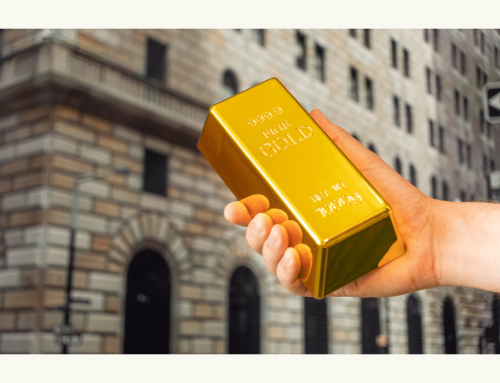Why Gold in your portfolio provides strength and protection.
When people think about investing, they often turn to stocks and bonds. These are the building blocks of many investment portfolios, providing a mix of growth and income. But there’s another option that has been used for centuries to protect wealth: physical gold. Including physical gold in your investment portfolio can add an extra layer of security and stability, especially during uncertain economic times.
What Makes Gold Different?
Gold is a tangible asset, meaning it’s something you can physically hold, like gold coins or bars. Unlike stocks or bonds, which are essentially paper assets tied to the performance of companies or governments, gold has intrinsic value. This means that gold’s worth is not dependent on the success of a business or the state of the economy.
A History of Value
Gold has been valued for thousands of years as a form of money and a store of wealth. It has been used across different cultures and societies, maintaining its appeal through various economic changes. When you invest in gold, you’re investing in an asset with a long history of retaining its value—something that can bring peace of mind in an unpredictable financial world.
Gold’s Historical Success During Market Crises
Imagine a time when your investments are at risk due to a market downturn. While stock values can plummet in a crisis, gold has consistently risen to the occasion. During the 2008 financial crisis, while the global stock market plunged, gold prices surged by over 25%. Similarly, in the 1970s, when the U.S. faced stagflation with inflation rates exceeding 13%, gold prices skyrocketed from $35 per ounce in 1971 to over $800 per ounce by 1980. And more recently, during the market turmoil of 2020, gold reached new highs as investors sought a safe haven.
These aren’t just numbers; they represent a track record of gold protecting wealth when other investments falter. Gold’s role during these crises isn’t just about survival—it’s about giving you the confidence that part of your portfolio is safeguarded against extreme market conditions.
Gold: The Strategic Asset for Modern Investors
In today’s complex financial landscape, safeguarding your wealth is about more than just chasing returns. It’s about building a resilient portfolio that can withstand economic storms. Gold isn’t just an old-fashioned hedge; it’s a strategic asset for the modern investor.
- Proactive Wealth Building: Think of gold as your portfolio’s safety net. It reduces overall risk, allowing your other investments the freedom to grow without the constant worry of a market collapse. When stocks dive, gold often acts as a stabilizer, cushioning your portfolio from severe losses.
- Independence from Financial Systems: Unlike stocks and bonds, which are vulnerable to the ups and downs of companies and economies, physical gold exists independently. There’s no risk of default, no dependence on a company’s performance. It’s a safeguard that stands firm when others waver.
How Gold Can Benefit Your Portfolio
Investing isn’t just about trying to make the most money; it’s also about protecting what you have. Ask yourself: Is your current portfolio prepared for the next market downturn or surge in inflation? Here’s where gold can play an important role:
- A Hedge Against Uncertainty: Gold often performs well during times of economic uncertainty. During the 2008 financial crisis, while many investments lost value, the price of gold increased. In times of trouble, investors often turn to gold as a “safe haven” to protect their wealth.
- Reducing Risk: Including gold in a mix of investments like stocks and bonds can reduce overall risk. If the stock market takes a downturn, gold’s value often remains stable or even increases, helping to balance your portfolio.
- Protection Against Inflation: Inflation means that the value of money decreases over time. This can erode the purchasing power of your investments. Historically, gold has tended to hold its value, or even appreciate, during periods of high inflation, making it a potential shield against the rising cost of living.
How Much Gold Should Be in a Portfolio?
You don’t need to invest all your money in gold to see its benefits. Many financial experts suggest including a portion of gold in your portfolio to help protect against market volatility and inflation. A balanced and strategic allocation often falls around 10%. For example, a diversified portfolio might look like this:
- 10% Gold: Providing stability and protection.
- 50% Stocks: Offering growth potential.
- 40% Bonds: Providing steady income and lower risk.
This mix aims to strike a balance between growth, income, and security. With 10% in gold, investors gain a hedge against market downturns and inflation without overly impacting the growth potential of their portfolio.
Balanced Portfolio Performance: Stability Over Maximum Returns
It’s important to consider how this balanced approach compares to a traditional portfolio of stocks and bonds. Over the past 10 years, a traditional portfolio with 60% in stocks and 40% in bonds would have yielded an annualized return of about 7.2%. Meanwhile, a balanced portfolio with 10% in gold, 50% in stocks, and 40% in bonds would have produced an annualized return of around 6.7%.
While the traditional portfolio offers a slightly higher return, the balanced portfolio with gold provides key advantages:
- Reduced Volatility: Gold acts as a stabilizer in times of market turbulence. Imagine your portfolio weathering a market crash because a portion of it is safeguarded by physical gold.
- Inflation Protection: Gold serves as a hedge against inflation, helping to preserve purchasing power when the value of paper currencies declines.
- Diversification Benefits: By including gold, investors add a layer of diversification that can protect against downside risks, especially during economic downturns or periods of market uncertainty.
Why Physical Gold?
There are different ways to invest in gold, but physical gold—like gold coins and bars—offers some unique advantages:
- Tangible Asset: Unlike stocks and bonds, which are digital or paper assets, physical gold is something you can hold in your hand. It’s not subject to the same risks as digital assets, such as market crashes or financial system failures.
- Global Acceptance and No Counterparty Risk: Physical gold is universally recognized and valued worldwide. It doesn’t rely on the performance of a company or financial institution, providing a level of security that other assets may not offer.
Gold as a Strategic Portfolio Protector
Imagine a future where your investments aren’t just about numbers on a screen, but about real, tangible security. Including physical gold in your portfolio isn’t just about adding another asset—it’s about ensuring a level of stability and protection that other investments might not provide. Whether you’re concerned about market downturns, inflation, or simply want to add a reliable safeguard to your investment strategy, gold has a history of holding its value and serving as a safe haven.
Gold isn’t just an option; for many, it’s a necessity for building a resilient financial future. It’s not merely about defense—it’s about taking a proactive step toward securing your wealth in an unpredictable world. Are your current investments ready for the challenges ahead? Exploring the role of physical gold in your portfolio could be the smart move that makes all the difference.
Disclaimer: This article is for informational purposes only and does not constitute financial or investment advice. Please consult a qualified financial advisor before making any investment decisions.






